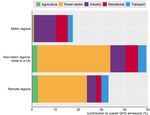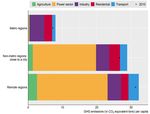Estonia Progress in the net zero transition - OECD
←
→
Page content transcription
If your browser does not render page correctly, please read the page content below
Regional Outlook 2021 - Country notes
Estonia
Progress in the net zero transition
PUBE
Disclaimer (for the referring document)
This document, as well as any data and map included herein, are without prejudice to the status of or sovereignty
over any territory, to the delimitation of international frontiers and boundaries and to the name of any territory, city
or area. Extracts from publications may be subject to additional disclaimers, which are set out in the complete
version of the publication, available at the link provided.2|
EMISSIONS
2018 OECD average: 2018 Estonian average: EU target:
11.5 tCO2e/capita 15.1 tCO2e/capita net zero GHG emissions by 2050
Large regions (TL2)
Figure 1. Estimated regional greenhouse gas emissions per capita Greenhouse gas (GHG) emissions
Tons CO2 equivalent (tCO2e), large regions (TL2), 2018 per capita generated in Estonia are
above the OECD average of 11.5
tCO2e per capita.
Small regions (TL3)
Figure 2. Contribution to estimated GHG emissions Figure 3. Estimated GHG emissions per capita
By type of small region, 2018 By type of small region, 2018
Across the OECD, metropolitan regions emit more greenhouse gases than remote regions. In Estonia, the reverse is
true. Emissions per capita in Estonian remote rural regions are much higher than in metropolitan regions. All region
types have increased production-based emissions per capita between 2010 and 2018.
Figure notes: Figures 1, 2, 3 and the OECD average show OECD calculations based on estimated greenhouse gas emissions data from the European Commission’s Joint
Research Centre (ECJRC). The Emissions Database for Global Atmospheric Research of the ECJRC allocates national greenhouse gas emissions to locations according to
about 300 proxies. See Box 3.7 in the 2021 OECD Regional Outlook for more details.|3
ENERGY
Estonian electricity mix
Figure 4. National electricity generation by energy source in 2019
Share of coal-fired (in Estonia: oil-shale fired) electricity generation
2030 well below 2°C benchmark for the EU:4|
Wind power
2030 well below 2°C benchmark for the EU:
2019 OECD average: 8% 2019 Estonian average: 9%
>29%
Figure 6. Regional wind power generation estimates Figure 7. Wind power potential
Per cent of total electricity generation, large regions (TL2), 2017 Mean wind power density (W/m2)
Source: Map produced by The Global Wind Atlas
Solar power
2030 well below 2°C benchmark for the EU:
2019 OECD average: 3% 2019 Estonian average: 0.7%
>14%
Figure 8. Regional solar power generation estimates Figure 9. Solar power potential
Per cent of total electricity generation, large regions (TL2), 2017 Global horizontal irradiation (kWh/m2)
Source: Map produced by The Global Solar Atlas
Estonia’s national average wind and solar power shares are still far below the 2030 benchmarks. Wind power density
is high offshore, and, to a lesser extent, along coast and some inland areas. Solar power potential is modest, and
higher in western regions.
Benchmark notes: The well-below 2 degrees benchmarks show IEA Sustainable Development Scenario (SDS) numbers. The SDS models how the global energy system can
evolve in alignment with the Paris Agreement’s objective to keep the global average temperature increase well below 2°C above pre-industrial levels. According to the Powering
Past Coal Alliance (PPCA), a phase-out of unabated coal by 2030 for OECD countries is cost-effective to limit global warming to 1.5°C.
Figure notes: Figure 4 shows data from the IEA (2020). Figures 5, 6 and 8 show OECD calculations based on the Power Plants Database from the WRI. The database captures
electricity generation from the power plants connected to the national power grid. As a result, small electricity generation facilities disconnected from the national power grid might
not be captured. See here for more details. Figures 7 and 9 show the power potential of solar and wind. Mean wind power density (WPD) is a measure of wind power available,
expressed in Watt per square meter (W/m²). Global horizontal irradiation (GHI) is the sum of direct and diffuse irradiation received by a horizontal surface, measured in kilowatt
hours per square metre (kWh/m2).|5
SECTORAL EMPLOYMENT RISKS
Figure 10. Employment in selected sectors which may be subject to employment loss by 2040 if emissions
are reduced in line with the Paris climate agreement
Per cent of total regional employment, large regions (TL2), 2017
There will be both employment gains and losses due to the transition to net zero greenhouse gas emissions. They
may not be distributed in the same way across regions. Employment in sectors that may be subject to some job loss
by 2040 as a result of policies to reduce emissions in line with the climate objectives in the Paris Agreement amounts
to less than 2.5% in Estonia. Estonia has less employment in these sectors than the OECD average. The selection
of sectors is broad and based on employment effects simulated across OECD countries (See Box 3.9 of the 2021
OECD Regional Outlook). It does not take specific local characteristics into account.
Figure notes: Figure 10 is based on data from OECD Statistics. Sectors are selected based on macroeconomic simulations of a scenario limiting global warming to well below 2
degrees. See Box 3.9 in the 2021 OECD Regional Outlook for more details.6|
TRANSPORT
Modal shift
Tallinn has average public transport Figure 11. Public transport performance in 2018
performance. For comparison, London (UK)
has among the highest public transport
performance scores. Inhabitants of the
metropolitan area of London can on average
reach 95% of the population living within 8 km
in 30 minutes by public transport.
Benchmark notes: In the IEA’s Sustainable Development Scenario, OECD countries (such as the European Union, Japan and the United States) as well as China fully phase
out conventional car sales by 2040. This scenario is aligned with the Paris Agreement’s objective to keep the global average temperature increase well below 2°C above pre-
industrial levels. The UK Committee on Climate Change finds that all new cars and vans should be electric (or use a low carbon alternative such as hydrogen) by 2035 at the
latest to reach net zero GHG emission targets by 2050. A more cost-effective date from the point of view of users is 2030.
Figure notes: Figure 11 is based on data from ITF and OECD Statistics. See Box 3.10 in the 2021 OECD Regional Outlook for more details. GDP per capita is expressed in USD
per head, PPP, constant prices from 2015.|7
AIR POLLUTION
Large regions (TL2)
2019 Estonian share of
2019 OECD share of population WHO-recommended air quality
population exposed above the
exposed above the WHO- threshold: PM2.5 annual mean
WHO-recommended threshold:
recommended threshold: 62% concentration < 10 µg/m3
0%
Figure 12. Share of population exposed to levels of air pollution above the WHO-recommended threshold
Percentage of population exposed to above 10 µg/m3 PM2.5, large regions (TL2), 2019
Policies towards net-zero greenhouse gas emissions can bring many benefits beyond halting climate change. They
include reduced air and noise pollution, reduced traffic congestion, healthier diets, enhanced health due to increased
active mobility, health benefits through thermal insulation, and improved water, soil and biodiversity protection. Some
are hard to quantify.
Small particulate matter (PM2.5) is the biggest cause of human mortality induced by air pollution. Major disease
effects include stroke, cardiovascular and respiratory disease. Air pollution amplifies respiratory infectious disease
such as Covid-19. It affects children the most. It reduces their educational outcomes as well as worker productivity.
Figure notes: Figure 12 is based on data from OECD Statistics.You can also read


























































